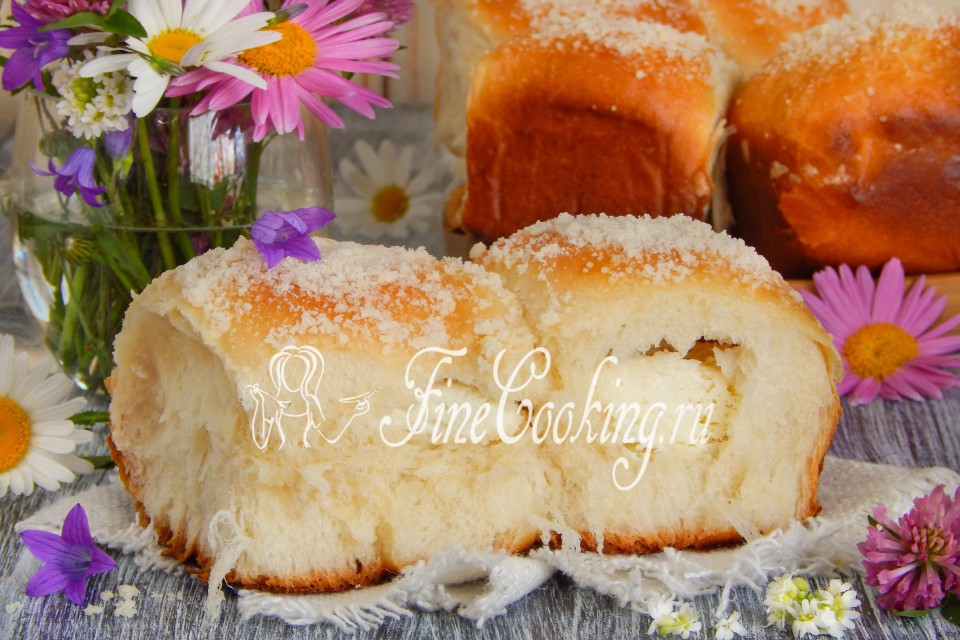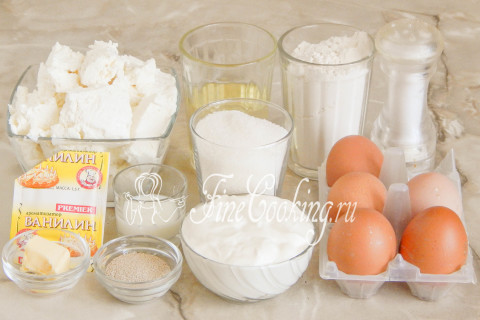Step 1
To prepare homemade yeast dough, take the highest grade wheat flour, sour cream of any fat content (I use 20%), medium-sized chicken eggs (45-50 grams each), refined vegetable (in my case, sunflower) oil, salt, sugar, speeding yeast and a little vanilla for the aroma. All ingredients must be at room temperature. The filling includes cottage cheese of any fat content (I took 5%), sugar, chicken egg and a little vanillin (optional). To lubricate the blanks (to make them appetizing and ruddy), you will need egg yolk and a little milk (as an option, you can use 1 whole chicken egg). In addition, I propose to sprinkle buns with a strap (crispy sand crumbs), for the preparation of which you need wheat flour (any grade), sugar and butter.
Step 2
First of all, we will make the preparation of yeast dough. It is more convenient to do all this in a bread maker or test, but it is very easy to mix it with your hands (manual kneads can be seen in the recipe for the outfits with fish). Depending on the model of the bread maker, the laying of the ingredients can be of two types: first liquid, then bulk and vice versa. I have the first option. Pour vegetable oil (without smell), sour cream and break the eggs into the bakery container. We’ll chat a little.
Step 3
Now add sifted wheat flour of the highest grade. I always use the same flour (Lida), so the grammar is always the same. You can leave more or less flour — it depends on its quality (product moisture).
Step 4
At the end, pour salt, sugar, a pinch of vanillin (can be replaced with a teaspoon of vanilla sugar) and high -speed yeast on different corners of the bowl.
Step 5
In my bread maker, the dough mode provides for the duration of kneading and proofing exactly 1 hour. But I don't like it so much, because the yeast test is at least 2 hours. That is why I recommend that you do as follows: we exhibit the main (3 hours) program or French bread (3 hours 50 minutes). The batch begins: on the first program, the first batch lasts 10 minutes, and in the second — 15 minutes. So much time is enough to knead the dough well and get an elastic, but at the same time soft and delicate bun. Literally after 5 minutes from the beginning of the batch, it must be formed. Moreover, this is a very important point, because the quality and humidity of the flour is different, therefore this product may require more or less than according to the recipe. If the bun can still not form, feel free to add a tablespoon of flour and follow the batch. When the dough completely moves away from the walls and will be quite elastic (that is, not to spread, but to keep the shape well), we stop the addition of flour. This is what my bun looked after 8 minutes of batch. Now leave the dough alone and let him grow up. It will take about 1 hour 40 minutes (main) or 2 hours 25 minutes (French bread), during which the bread machine will take a fry twice (three times). I prefer to use the second program. If you knead the dough with your hands, knead it for 10-15 minutes, then tighten the bowl with a film or cover with a towel. The fermentation of the dough lasts in the warmth for 2 hours. After 1 hour, we make a light grinder of the dough, rounding and repeated fermentation for another 1 hour.
Step 6
While the yeast dough wanders, we will take up the filling for future buns. It is advisable (but not necessarily) to wipe the cottage cheese through a sieve so that it becomes more tender. If the product itself is scattered, in finished form in the filling, large pieces can occur, and not everyone likes this.
Step 7
Add sugar, egg and vanillin for the aroma to cottage cheese.
Step 8
Mix everything — the filling for yeast buns is ready. If you wish, you can safely regulate the amount of sugar (it depends on how sour cottage cheese you have and how sweet the filling you love). In addition, you can add raisins without bones to the filling, chopped prunes or dried apricots, tsukata is a matter of taste.
Step 9
When the dough is suitable, it will be airy and very tender. Turn off the program when on the timer will be 1:10 (main and French bread). That is, we take out the dough 10 minutes before the assistant begins to bake bread.
Step 10
It remains to sprinkle the yeast dough to release air, transfer it to the board (plate) and proceed to molding the blanks.
Step 11
We divide the dough into pieces of the same size — I have 15 pieces, each weighing about 67 grams. It is very convenient to use kitchen weights so that the blanks are of the same weight. This is important not only from an aesthetic point of view, but also in order for the baking to evenly part and bake the same way. We roll each piece in a ball and put on a board, very slightly sprinkled with flour. If you have not yet filled your hand in the modeling of pies, that is, the process takes a lot of time from you, cover all the pieces of dough with a film or towel so that you do not be blurred.
Step 12
We proceed to the molding of future buns with cottage cheese filling. We take one ball of dough and flatten it with a palm. If you want, you can roll out with a rolling pin — this is not fundamentally, since the dough is very tender and supple, it is perfectly stretched with your hands.
Step 13
We put a certain amount of curd filling in the center. Then I acted by eye — about 1 tablespoon per 1 bun.
Step 14
We pinch the dough so that the fillings are not visible. The yeast dough according to this recipe turns out to be very plastic and crawls perfectly. Literally a couple of movements and the bun is ready.
Step 15
Carefully roll the workpiece in the palms to get an even shape and put the future pie with a seam down.
Step 16
The baking sheet (in my case, this is a rectangular shape for baking) is covered with baking paper and lay the blanks with a seam down on it.
Step 17
We cover with a towel or cling film and leave to stand up for 25-30 minutes. Immediately turn on the oven to heat up 180 degrees and make a strapel.
Step 18
Straisel is such a tasty and crispy baby that will be perfectly combined with delicate yeast dough. It can be done both in the dishes and right on the table — to whom it is more convenient. The classic recipe for a stratesel involves standard proportions: for 1 part of butter, we take 2 parts of sugar and flour. That is, we simply put 20 grams of sugar and wheat flour in a bowl, add 10 grams of butter (soft or cold — it does not matter).
Step 19
It is most convenient for me to first rub sugar with butter, and then add flour.
Step 20
Ripe everything with a fork or right between the palms to get a crumbly oil crumb. Flour may need a little more or less depending on its humidity. The main thing is that you have exactly a small-small crumb, and not a homogeneous dough. The straps can be made more and stored in the freezer for up to several months is very convenient. They can sprinkle muffins, muffins, buns, casseroles …
Step 21
When yeast buns is suitable, they will noticeably round and increase in volume. In order for the pastries to turn out to be beautiful and ruddy, I propose to lubricate them with egg yolk with milk — we just chat them with a fork and the lubricant is ready. Small secret: if your oven does not want to blush pastries, add a pinch of powdered sugar to the yolk. Then, in the process of baking, sugar is caramelization and the top of the buns or pies will be browned. I used to do this sometimes with pastries, because the old oven sometimes failed me. Lubricate the workpieces that have already managed to fit well.
Step 22
Sprinkle with a strap and send it to a hot oven to an average level to bake for about 25-35 minutes at 180 degrees. I have a gas oven, the lower heating works, convection is not provided.
Step 23
Choose the degree of blush of yeast, someone loves only slightly golden, and someone likes an almost brown crust.
Step 24
Ready -made yeast buns with cottage cheese is unusually aromatic, so delicious and very tasty. In this home baking, the air and very soft dough goes well with a delicate curd filling. Polynochka, thank you very much for this delicious order. Prepare for health and pleasant to you appetite, friends!
























